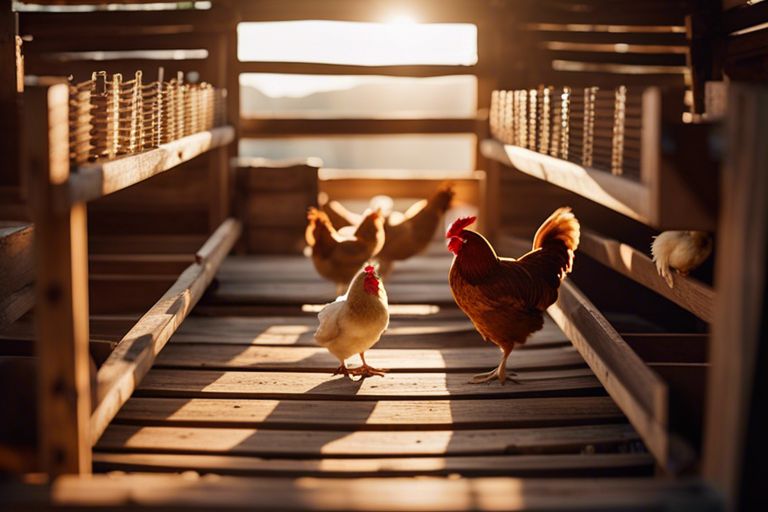Roosting Bars and Perches – Comfortable Resting Spots
There’s no doubt that providing your birds with comfortable roosting bars and perches is essential for their overall health and well-being. In this blog post, we will explore the importance of these resting spots for poultry, including the different types available and how to ensure they are properly installed in your coop. By understanding the significance of roosting bars and perches, you can create a safe and cozy environment for your feathered friends to rest and relax.
Understanding Roosting Bars and Perches
Your poultry’s comfort and well-being are crucial aspects of raising healthy birds. Providing them with suitable roosting bars and perches is an essential component of their housing setup. Understanding the importance and differences between these resting spots can help create a comfortable environment for your feathered friends.
The Importance of Resting Spots for Birds
Any bird owner knows that rest is vital for their flock’s health. Birds spend a significant portion of their day perching and roosting, not just for resting but also for safety from ground predators. Adequate perching spaces allow birds to comfortably roost, sleep, and preen their feathers, promoting their overall well-being.
In addition to providing a place for rest, roosting bars and perches encourage natural behavior in birds. By mimicking their natural habitat and giving them elevated spots to perch on, you are helping them feel secure and content in their environment.
Differences Between Roosting Bars and Perches
Resting spots for birds can come in various forms, but the two most common types are roosting bars and perches. Roosting bars are typically wider and flat, allowing birds to roost comfortably with their feet flat on the surface. On the other hand, perches are narrower and rounded, encouraging birds to grip them with their toes to maintain balance.
Between roosting bars and perches, the choice often depends on the bird’s species and preferences. Some birds, like chickens, prefer roosting bars to perch at night. Others, like parrots, enjoy perches that challenge their feet and keep them engaged. Understanding these differences can help you provide the most suitable resting spots for your specific bird species.
Design Essentials for Comfortable Resting Spots
Assuming you want to provide the best comfort for your flock, designing the roosting bars and perches in your coop requires careful consideration. Comfortable resting spots are essential for your chickens’ well-being and productivity.
Material Selection for Roosting Bars and Perches
The material you choose for your roosting bars and perches can greatly impact your chickens’ comfort. Opt for smooth, rounded materials such as untreated wood or PVC pipes to prevent injury to your chickens’ feet. Avoid rough or sharp-edged materials that can cause discomfort or even potential injuries. Additionally, make sure the material is easy to clean to maintain a healthy environment in the coop.
Optimal Sizing and Spacing
With roosting bars and perches, the optimal sizing and spacing are crucial for ensuring your chickens can roost comfortably. Make sure the bars are wide enough for your chickens to comfortably perch without their toes hanging off the edges. The spacing between bars should allow enough room for each chicken to roost without feeling cramped or overcrowded.
It’s essential to provide enough space between the bars to prevent overcrowding and potential aggression among your flock. A general rule of thumb is to allow about 8-10 inches of roosting space per bird. This ensures that each chicken has enough room to perch comfortably and rest without feeling cramped.
Installation and Placement Strategies
Obviously, when it comes to providing comfortable resting spots for your birds, the installation and placement of roosting bars and perches play a crucial role in ensuring their well-being and comfort. Let’s explore some best practices for installation as well as strategic placement within aviaries and coops.
Best Practices for Roosting Bar Installation
For optimal comfort and safety, roosting bars should be installed at a height of 18 inches to 2 feet above the ground. Ensure that the bars are sturdy enough to support the weight of your birds without sagging or bending. It is also important to provide enough linear space per bird to prevent overcrowding and ensure that they have enough room to perch comfortably.
When installing roosting bars, make sure they are positioned away from feed and water sources to prevent contamination from droppings. Additionally, consider installing removable bars to facilitate cleaning and maintenance tasks, ensuring a hygienic and comfortable resting area for your feathered friends.
Strategic Perch Placement Within Aviaries and Coops
For optimal flock dynamics and bird health, strategic placement of perches within aviaries and coops is essential. Ensure that perches are placed at varying heights to accommodate birds’ natural instincts to roost at different levels. Incorporate different types of perches, such as natural branches or commercial perches, to promote foot health and provide a stimulating environment for your birds.
With strategic perch placement, you can encourage natural behaviors such as flying, jumping, and perching, promoting physical exercise and mental stimulation for your birds. By creating a well-designed roosting and perching area, you can enhance the overall comfort and well-being of your feathered companions, leading to happier and healthier birds in your care.
Maintenance and Hygiene
Cleaning and Sanitation of Resting Spots
The key to keeping your roosting bars and perches in good condition is regular cleaning and sanitation. The droppings and feathers that accumulate on these surfaces can harbor bacteria and parasites, posing a risk to your flock’s health. It is essential to remove any debris and scrub the bars or perches thoroughly using a mild disinfectant solution.
Ensure the resting spots are completely dry before allowing your chickens to roost on them again. Moist environments are breeding grounds for harmful microorganisms. By maintaining cleanliness, you can prevent the spread of diseases and ensure a comfortable resting area for your birds.
Periodic Inspection and Maintenance Tips
Regular inspection of roosting bars and perches is crucial to identify any signs of wear and tear. Look for cracks, splinters, or loose fittings that could potentially harm your chickens. Replace any damaged parts immediately to prevent injuries to your flock.
For optimal comfort, consider adding a layer of soft bedding on the perches. This not only provides a cozy resting spot for your chickens but also absorbs droppings, making cleaning easier. Additionally, trim any overgrown nails on your birds to prevent them from getting caught in the perches.
- Inspect roosting bars and perches weekly for any damage or signs of wear and tear.
- Replace any broken or worn-out parts promptly to maintain a safe environment for your chickens.
For instance, checking the stability of the roosting bars and perches periodically can prevent accidents and injuries to your birds. Regular maintenance not only ensures the structural integrity of these resting spots but also promotes the overall well-being of your flock.
Common Challenges and Solutions
Addressing Wear and Tear
On occasion, roosting bars and perches may show signs of wear and tear due to continuous use by your feathered friends. This could lead to weakened structures or splintering, which may pose a risk to your birds. To address this, regularly inspect the bars and perches for any signs of damage such as cracks, loose screws, or sharp edges. If you notice any issues, it is essential to repair or replace the affected parts promptly to ensure the safety and comfort of your flock.
Additionally, consider using materials that are durable and resistant to wear for your roosting bars and perches. Hardwoods like oak or cedar are excellent choices as they are sturdy and less prone to damage. Applying a protective sealant can also help prolong the lifespan of the bars and perches, keeping them in optimal condition for your birds to roost comfortably.
Preventing and Managing Parasites
Solutions for preventing and managing parasites in your chicken coop include regular cleaning and disinfection of the roosting bars and perches. Parasites like mites and lice can hide in crevices and cracks, so thorough cleaning with a mild detergent or vinegar solution can help eliminate them. Additionally, consider using diatomaceous earth or other natural remedies to deter parasites and keep your coop environment healthy for your birds.
It is crucial to monitor your flock regularly for signs of parasite infestations, such as feather loss, lethargy, or irritability. If you suspect a parasite problem, consult with a veterinarian or poultry expert for guidance on treatment options and preventive measures to protect your birds and maintain a hygienic coop environment.
Final Words
The placement and design of roosting bars and perches in a chicken coop are crucial elements that directly impact the comfort and well-being of your flock. By providing adequate space, a variety of heights, and materials that are comfortable for your chickens’ feet, you can create a relaxing environment where your birds can rest, sleep, and feel secure. Remember to regularly clean and inspect these resting spots to ensure they remain in good condition. With these considerations in mind, your chickens will have cozy and inviting spaces to roost, promoting their overall health and happiness.



